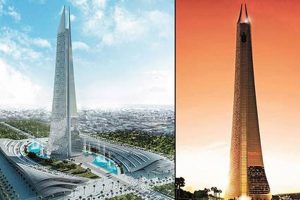Skyscraper, a very tall, continuously habitable building, having multiple floors. Modern skyscrapers have a steel framework, with the exterior walls supported by the framework rather than by the interior walls. This permits large windows on all sides of the building and provides column-free interior spaces. Skyscrapers are usually built in cities where land is scarce and expensive.
The first skyscraper was the Home Insurance Building in Chicago, completed in 1885. It was 10 stories tall and had a steel frame. The first skyscraper to exceed 100 stories was the Empire State Building in New York City, completed in 1931. It was 102 stories tall and had a steel frame. The tallest skyscraper in the world is the Burj Khalifa in Dubai, completed in 2010. It is 163 stories tall and has a reinforced concrete core with a steel exterior.
Skyscrapers have many advantages. They can accommodate a large number of people in a relatively small area. They can also be used for a variety of purposes, including offices, apartments, hotels, and retail stores. Skyscrapers can also be designed to be energy-efficient and environmentally friendly.
1. Height
The height of a skyscraper is one of its defining characteristics. Skyscrapers are very tall buildings, typically over 100 stories. This height allows them to accommodate a large number of people and a variety of uses in a relatively small area. Skyscrapers are often built in cities where land is scarce and expensive. Their height allows them to maximize the use of the available land.
The height of a skyscraper also has a number of practical benefits. It allows for better views, more natural light, and improved air quality. Taller buildings are also less likely to be affected by street noise and pollution. In addition, the height of a skyscraper can be used to create a variety of architectural effects. For example, the Burj Khalifa in Dubai uses its height to create a distinctive spire that is visible from miles away.
The height of a skyscraper is an important factor in its design and construction. It must be able to withstand the forces of wind and gravity, and it must be able to provide a safe and comfortable environment for its occupants. The height of a skyscraper is also a symbol of its status and importance. Skyscrapers are often built to be the tallest buildings in a city or even in the world. They are a symbol of a city’s economic and architectural prowess.
2. Floors
Skyscrapers have multiple floors, providing ample space for various uses. This is one of the defining characteristics of a skyscraper, and it is what makes them so versatile and useful. The multiple floors of a skyscraper can be used for a variety of purposes, including offices, apartments, hotels, retail stores, and even parking garages.
The multiple floors of a skyscraper allow it to accommodate a large number of people and activities in a relatively small area. This is especially important in cities where land is scarce and expensive. Skyscrapers can help to maximize the use of the available land, and they can also help to reduce traffic congestion by reducing the need for people to commute to different parts of the city.
The multiple floors of a skyscraper also provide a variety of practical benefits. For example, the higher floors of a skyscraper typically have better views and more natural light. The lower floors of a skyscraper are often used for retail stores and other public spaces, which can be more easily accessible to pedestrians. In addition, the multiple floors of a skyscraper can be used to create a variety of architectural effects. For example, some skyscrapers have stepped-back floors, which can create a more visually interesting appearance. Other skyscrapers have curved floors, which can help to reduce wind resistance.
The multiple floors of a skyscraper are an important part of what makes them such a versatile and useful building type. They allow skyscrapers to accommodate a large number of people and activities in a relatively small area, and they provide a variety of practical benefits. As a result, skyscrapers are an important part of the urban landscape, and they continue to be built in cities around the world.
3. Steel frame
The steel frame is a defining characteristic of modern skyscrapers. It is what allows them to be so tall and have such large windows and column-free interior spaces. Without a steel frame, skyscrapers would not be able to withstand the forces of wind and gravity, and they would not be able to provide the same level of comfort and convenience to their occupants.
The steel frame of a skyscraper is typically made of high-strength steel, which is very strong and durable. The steel frame is also very flexible, which allows it to withstand the forces of wind and gravity without breaking. The steel frame is also fire-resistant, which helps to protect the building in the event of a fire.
The steel frame of a skyscraper is typically constructed by welding together individual steel beams. The steel beams are then bolted together to form the frame of the building. The steel frame is then covered with a layer of concrete or other fire-resistant material to protect it from the elements.
The steel frame of a skyscraper is a critical component of the building’s design and construction. It is what allows skyscrapers to be so tall and have such large windows and column-free interior spaces. The steel frame also helps to protect the building from the forces of wind and gravity, and it makes the building more fire-resistant.
4. Urban areas
Skyscrapers are most commonly associated with urban areas due to several reasons:
- High land value: In cities, land is often scarce and expensive, making it necessary to build upwards to maximize space utilization.
- Population density: Densely populated urban areas require compact and efficient housing solutions, which skyscrapers provide with their verticality.
- Economic activity: Cities are hubs of economic activity, attracting businesses and individuals who require office space, commercial facilities, and other amenities that skyscrapers offer.
- Transportation infrastructure: Urban areas have well-developed transportation systems, making it convenient for people to access tall buildings from different parts of the city.
These factors contribute to the prevalence of skyscrapers in urban environments, shaping the cityscape and accommod
ating the needs of modern urban living.
5. Mixed-use
The mixed-use aspect of skyscrapers is a defining characteristic that sets them apart from other types of buildings. Skyscrapers can accommodate a wide range of functions within a single structure, including offices, apartments, hotels, and retail stores. This versatility contributes significantly to the definition of a skyscraper and its role in modern urban environments.
The mixed-use nature of skyscrapers stems from the need for efficient space utilization, particularly in densely populated urban areas where land is scarce and expensive. By combining multiple functions into a single vertical structure, skyscrapers maximize the value of the available land and reduce the need for separate buildings for each purpose. This compact and efficient design allows for a more sustainable use of urban space.
The practical significance of mixed-use skyscrapers is evident in their ability to create vibrant and self-contained communities within urban centers. Residents and workers can live, work, shop, and socialize within the same building complex, reducing the need for long commutes and promoting a more sustainable lifestyle. Mixed-use skyscrapers also contribute to the economic vitality of cities by attracting businesses and generating employment opportunities.
In conclusion, the mixed-use aspect of skyscrapers is an essential component of their definition and plays a crucial role in shaping the urban landscape. By combining multiple functions into a single vertical structure, skyscrapers maximize space utilization, promote sustainability, and create vibrant and self-contained communities within cities.
6. Energy efficiency
In the context of skyscraper definition, energy efficiency is a crucial aspect contributing to the overall sustainability and functionality of these towering structures. Skyscrapers, with their immense height and complex systems, require careful consideration of energy consumption and environmental impact. To this end, various energy-efficient measures and sustainable design strategies are incorporated into skyscraper construction and operation.
- Building Envelope Optimization:
Skyscrapers feature advanced building envelopes designed to minimize heat gain or loss, reducing the energy required for heating and cooling. These envelopes incorporate high-performance glazing, insulation, and shading systems to regulate temperature and daylighting effectively.
- Efficient Lighting Systems:
Skyscrapers utilize energy-efficient lighting systems, such as LED fixtures and daylight harvesting controls, to reduce electricity consumption. These systems automatically adjust lighting levels based on natural light availability, reducing energy waste and creating a more comfortable indoor environment.
- Renewable Energy Integration:
Many skyscrapers incorporate renewable energy sources into their design, such as solar panels and wind turbines. These systems generate clean energy, reducing reliance on fossil fuels and contributing to the building’s overall sustainability.
- Water-Efficient Fixtures:
Skyscrapers are equipped with water-efficient fixtures, including low-flow toilets, faucets, and rainwater harvesting systems. These measures minimize water consumption and contribute to the building’s environmental friendliness.
By implementing these energy-efficient and environmentally friendly measures, skyscrapers not only reduce their operating costs and environmental impact but also contribute to the creation of a more sustainable and responsible built environment.
7. Architectural landmarks
Skyscrapers are not just towering structures that dominate the urban landscape, but they also serve as architectural landmarks that define the identity and character of a city. Their iconic designs and unique features make them instantly recognizable and deeply embedded in the collective memory of a city’s inhabitants and visitors.
- Symbolism and Identity: Skyscrapers often embody the spirit and aspirations of a city. Their height, grandeur, and architectural style can reflect the city’s economic strength, cultural heritage, and futuristic ambitions. For example, the Empire State Building in New York City has become an iconic symbol of American prosperity and architectural achievement.
- Tourism and Recognition: Landmark skyscrapers attract tourists from around the world, eager to witness these architectural wonders firsthand. Their unique designs and observation decks offer breathtaking views of the city, making them popular destinations for both domestic and international visitors. The Petronas Towers in Kuala Lumpur, with their distinctive twin towers and skybridge, have become a major tourist attraction in Southeast Asia.
- Urban Planning and Development: Skyscrapers play a significant role in urban planning and development. Their vertical orientation allows for efficient land use in densely populated urban areas, maximizing space and reducing urban sprawl. The Marina Bay Sands in Singapore, with its iconic three towers and rooftop infinity pool, is an example of how skyscrapers can transform a city’s skyline and create new landmarks.
- Architectural Innovation and Design: Skyscrapers push the boundaries of architectural design and engineering. They showcase innovative construction techniques, sustainable materials, and cutting-edge technologies. The Burj Khalifa in Dubai, the world’s tallest building, is a testament to human ingenuity and the pursuit of architectural excellence.
In conclusion, the architectural landmark status of skyscrapers is an integral part of their definition. These towering structures not only provide practical functions but also serve as symbols of urban identity, tourist destinations, catalysts for urban development, and platforms for architectural innovation. They shape the skyline of a city, leaving a lasting legacy on its cultural and architectural landscape.
8. Economic drivers
Skyscrapers are not merely architectural marvels; they also serve as economic powerhouses that contribute to the growth and prosperity of cities. Their ability to attract businesses and residents plays a pivotal role in driving economic development. This aspect is deeply intertwined with the definition of a skyscraper, as it underscores the broader impact these structures have beyond their physical presence.
The economic benefits of skyscrapers are multifaceted. Firstly, they provide ample office space for businesses, fostering job creation and economic activity. The concentration of businesses in skyscrapers creates a hub for commerce and innovation, attracting skilled workers and entrepreneurs. Secondly, skyscrapers offer luxurious residential units, appealing to affluent individuals and families. This influx of residents boosts
the local economy by increasing demand for goods and services, such as retail,, and entertainment.
Real-life examples abound to illustrate the economic impact of skyscrapers. The construction of the Empire State Building in New York City during the Great Depression not only provided jobs but also boosted the morale of the city. Similarly, the Petronas Towers in Kuala Lumpur have become a catalyst for economic growth in Malaysia, attracting foreign investment and tourism. These iconic skyscrapers have transformed their respective cities into thriving business and financial centers.
Understanding the economic significance of skyscrapers is crucial for urban planners and policymakers. By incorporating skyscrapers into urban development strategies, cities can harness their potential to stimulate economic growth, create employment opportunities, and enhance the overall quality of life. This understanding also highlights the need for sustainable and responsible skyscraper development, ensuring that these structures contribute positively to the urban environment and the well-being of its inhabitants.
FAQs on Skyscraper Definition
Skyscrapers, as defined earlier, are exceptionally tall, continuously habitable structures with multiple floors. To further clarify this concept, let’s address some frequently asked questions.
Question 1: What is the primary purpose of skyscrapers?
Answer: Skyscrapers serve diverse purposes, including accommodating offices, residential units, retail stores, hotels, and more. Their vertical orientation allows for efficient land use, especially in densely populated urban areas.
Question 2: What factors contribute to defining a skyscraper’s height?
Answer: The height of a skyscraper is typically measured from the ground to its architectural top, excluding antennas or other non-habitable structures.
Question 3: Are skyscrapers designed to withstand natural disasters?
Answer: Modern skyscrapers incorporate advanced engineering techniques and materials to enhance their resilience against earthquakes, hurricanes, and other natural disasters.
Question 4: How do skyscrapers contribute to sustainability?
Answer: Many skyscrapers employ sustainable design features, such as energy-efficient systems, water conservation measures, and the use of eco-friendly materials.
Question 5: What are some iconic skyscrapers around the world?
Answer: Notable examples include the Burj Khalifa in Dubai, the Empire State Building in New York City, and the Petronas Towers in Kuala Lumpur.
Question 6: What is the future of skyscraper design?
Answer: As technology and architectural innovation advance, skyscrapers are likely to become even taller, more sustainable, and integrated with smart city technologies.
In essence, skyscrapers are not just towering structures but also multifaceted urban landmarks that contribute to economic growth, sustainability, and architectural advancements.
Transition to the next article section:
Tips for Understanding Skyscraper Definition
Delving deeper into the definition of skyscrapers, here are several practical tips to enhance your understanding:
Tip 1: Consider Historical Context
To fully grasp the concept of skyscrapers, explore their historical evolution. Trace the development of early high-rise buildings to modern supertall structures, understanding the technological advancements and architectural innovations that shaped their design.
Tip 2: Focus on Key Characteristics
Identify the defining characteristics of skyscrapers that differentiate them from other tall buildings. These may include extreme height, multiple floors, steelstructures, and a predominant urban setting.
Tip 3: Analyze Functional Diversity
Recognize that skyscrapers are not limited to a single purpose. They can accommodate a mix of functions, such as offices, residential units, retail spaces, and hospitality venues. This versatility contributes to their significance in urban environments.
Tip 4: Explore Engineering Aspects
Understand the engineering marvels that make skyscrapers possible. Study the use of advanced materials, innovative structural systems, and wind-resistant designs that enable these towering structures to withstand various forces.
Tip 5: Examine Sustainability Features
Modern skyscrapers often incorporate sustainable design elements. Investigate how skyscrapers can achieve energy efficiency, reduce water consumption, and promote environmentally responsible practices.
Tip 6: Appreciate Architectural Impact
Recognize the architectural significance of skyscrapers. Their iconic designs, often shaped by renowned architects, contribute to the identity and character of cities. Skyscrapers can serve as symbols of innovation, cultural expression, and urban development.
Summary:
By incorporating these tips, you can develop a comprehensive understanding of skyscrapers, their defining features, and their multifaceted roles in shaping urban landscapes worldwide.
Conclusion
In exploring the definition of a skyscraper, we have delved into its essential characteristics, functional diversity, and architectural significance. Skyscrapers, as exceptionally tall, continuously habitable structures with multiple floors, have transformed urban landscapes worldwide.
The defining features of skyscrapers extend beyond their height to encompass their steel frameworks, which enable large windows and column-free interior spaces. Their versatility allows them to accommodate a wide range of functions, from offices and apartments to retail stores and hotels, contributing to the vibrancy of urban centers.
Furthermore, skyscrapers are not merely architectural marvels but also symbols of economic growth, innovation, and cultural expression. Their iconic designs, often shaped by renowned architects, contribute to the identity and character of cities. As technology advances and sustainable practices become increasingly important, the future of skyscraper design promises to be even more groundbreaking and eco-conscious.
Understanding the definition of a skyscraper is not just about comprehending its physical attributes but also appreciating its multifaceted roles in shaping urban environments. Skyscrapers are more than just tall buildings; they are testaments to human ingenuity, economic powerhouses, and architectural landmarks that continue to redefine the skylines of cities around the globe.







